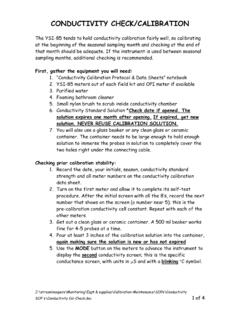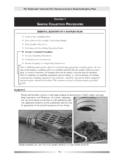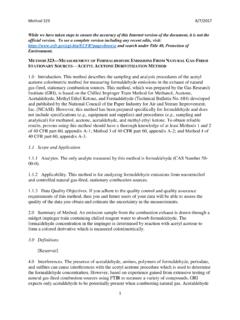Transcription of GRAB SAMPLING FIELD PROCEDURE: GRAB …
1 GRAB SAMPLING FIELD procedures 11th Edition, 2009 FIELD PROCEDURE: GRAB SAMPLING FOR LAB analysis ( bacteria , NITRATES, ETC.) (NOTE: The regular stream teams do not perform this procedure. A special Grab Sample Team collects a large number of these samples in a single day, in what s known as a site tour in the Clallam County Water Resources database.) EQUIPMENT NEEDED: Streamkeepers Fecal/ nitrate Sample Tracking Sheets one per team per day Clipboard, pencils Directions to collection sites Sterile bottles, enough for each team s collection, plus replicates, plus a few more Watch to tell time Latex gloves Streamkeepers business cards Waterproof marking pen Thermometer Salinity meter optional (see below) SAMPLING wand to attach bottles to Large cooler to keep in car Portable cooler to carry to sites Gel ice packs or ice (preferably crushed or shaved) to maintain temperatures below 39 F/4 C SPECIAL EQUIPMENT FOR nitrate SAMPLES.
2 Clallam County IOCS Reports for Nitrates enough for each team s collection, plus replicates, plus a few more Sterile bottles, enough for each team s collection, plus replicates, plus a few more nitrate test strips one per site Rubber bands Ziplock bags WHY GRAB SAMPLES? Many types of water analysis are exclusively or optimally performed in a laboratory. This protocol describes SAMPLING for bacteria and nitrate analysis , but similar procedures can be used for many other types of analysis . WHY SAMPLE FOR bacteria & NITRATES? Microorganisms and nitrates are naturally present in streams, but humans can change both the quantity and nature of these inputs in a way that upsets nature s balance: Pathogenic (disease-causing) micro-organisms that humans or domestic animals introduce to water including varieties of bacteria , viruses, and protozoans can cause diseases in humans and animals alike, including salmonella, hepatitis, and giardia.
3 Undisturbed streams generally contain less than 1 mg/L of nitrate -nitrogen (the part of the nitrate ion consisting of elemental nitrogen). Levels above 10 mg/L have been connected with Blue Baby Syndrome, reduced livestock vitality, and brown blood disease in fish. Excessive inputs of nitrates (through fertilizers, livestock, or leaking septic tanks) to water can lead to eutrophication--a massive build-up and die-off of vegetative matter that takes up the available dissolved oxygen in the water and suffocates fish and the macroinvertebrates they depend on. nitrate loading can be particularly devastating to nearshore marine areas. When elevated levels of pathogens or nitrates are present, water quality is at risk.
4 One way to test for the presence of human-introduced pathogenic microorganisms is to focus on fecal coliform bacteria , which primarily live in the digestive systems of warm-blooded animals, aiding digestion. These bacteria , though not pathogenic themselves, are good indicators of human or animal waste contamination, which often carries other more harmful organisms that are harder to test for. Hence, Washington State water quality standards use fecal coliforms as the indicator of potential pathogenic conditions in streams. GRAB SAMPLING FIELD procedures 11th Edition, 2009 However, since some forms of fecal coliform bacteria do not have an animal origin, laboratories can also test for strains that are primarily traceable to animals--Escherichia coli (E.)
5 Coli) or enterococcus--to confirm animal contamination. Neither bacteria nor nitrates can be accurately measured in the FIELD . Hence, the Streamkeepers protocol is to: have regular Stream Teams screen all reaches for nitrates on a quarterly basis with test strips (which, though neither accurate nor precise, can alert to potential red flag situations), and to have a separate Grab Sample Team take samples for laboratory bacteriological testing (total fecal coliforms and/or E. Coli presence) near the mouth of every monitored stream, also on a quarterly basis. If either nitrate test strips or bacterial samples indicate a problem, the Grab Sample Team may be asked to do further SAMPLING for bacteria or nitrates.
6 WHERE TO SAMPLE: Quarterly samples for bacteria will generally be taken on each stream that Streamkeepers monitor, at a site near the mouth. In the case of an identified problem or special-project request, additional sites may be sampled. WHEN TO SAMPLE: Time of year: Routine bacterial samples will be taken quarterly during the following times: January April or May August 1 September 15 October 5 31 The Grab Sample Team will decide on what day to sample, taking into consideration the factors listed below. ANY proposed SAMPLING date must be confirmed two weeks in advance with the processing laboratory (usually the Clallam County Environmental Health Lab, 360-417-2334. NOTE: The lab does not take samples on Fridays.)
7 Notify Streamkeepers staff when you have scheduled a SAMPLING date, and arrange to pick up the equipment. Non-routine bacterial and nitrate samples will be scheduled ad hoc in conjunction with Streamkeepers staff. Time of day: Ordinarily, fecal samples must be delivered by 2 and within 6 hours of the first sample, but some projects may differ; nitrate samples may be stored for 48 hours at 4 C. If you re running late, don t decide to skip your final sites before calling the lab manager at 417-2334, and trying to make special arrangements. This is often possible. Avoiding tidal interference: What you should be testing is the freshwater runoff of the stream, not what might surge in on a high tide.
8 To avoid tidal interference: The Grab Sample team should check the tide tables before planning their collection day. Tide chart can be found in current phone book or online at Samples taken near the mouths of streams should be taken on an outgoing tide. In general, you can sample hour after mean high tide, defined as the point halfway between the high-low tide and low-high tide for the day. If a salinity meter is available, take it along and sample salinity. Note the reading on the tracking sheet. Be sure that the water is flowing downstream when you sample. If the tide has turned and you notice upsurge effects, note that on the tracking sheet and plan your next sample day to avoid such situations!
9 Sites that are well above the stream mouth should have no problem with tidal interference. FIELD REPLICATES: Our quality control plan requires that at one SAMPLING point out of every ten (or portion thereof), a second sample be collected for a replicate test. FIELD replicates give an indication of how much variability there is in the equip-GRAB SAMPLING FIELD procedures 11th Edition, 2009 ment, SAMPLING techniques, and environment. To perform and record FIELD replicates: Streamkeepers staff or the team leader will determine how many replicate samples need to be collected, select sites for replicates, and then notify team members where they ll need to collect replicates. At the replicate site(s), the team will grab a second sample, as soon as possible after the first, and in the same spot.
10 On the Streamkeepers Sample Tracking Sheet, write FR in the FIELD Rep? column on the line for the replicate sample (see sample FIELD sheet at the end of this section). FIELD PROCEDURE: For safety purposes, at least two people must go out together to collect grab samples. 1) Fill the car cooler with ice or ice packs. Keep the thermometer in a place where it will be near the outside temperature. 2) Take the portable cooler with you to each site, with enough ice to chill the sample(s) until you get them back to the car cooler. 3) When first arriving at the site, hang the thermometer in a shady spot. 4) Collecting the sample: Gloves are optional but preferred, and you can use the SAMPLING wand to avoid having to wade in the stream.








